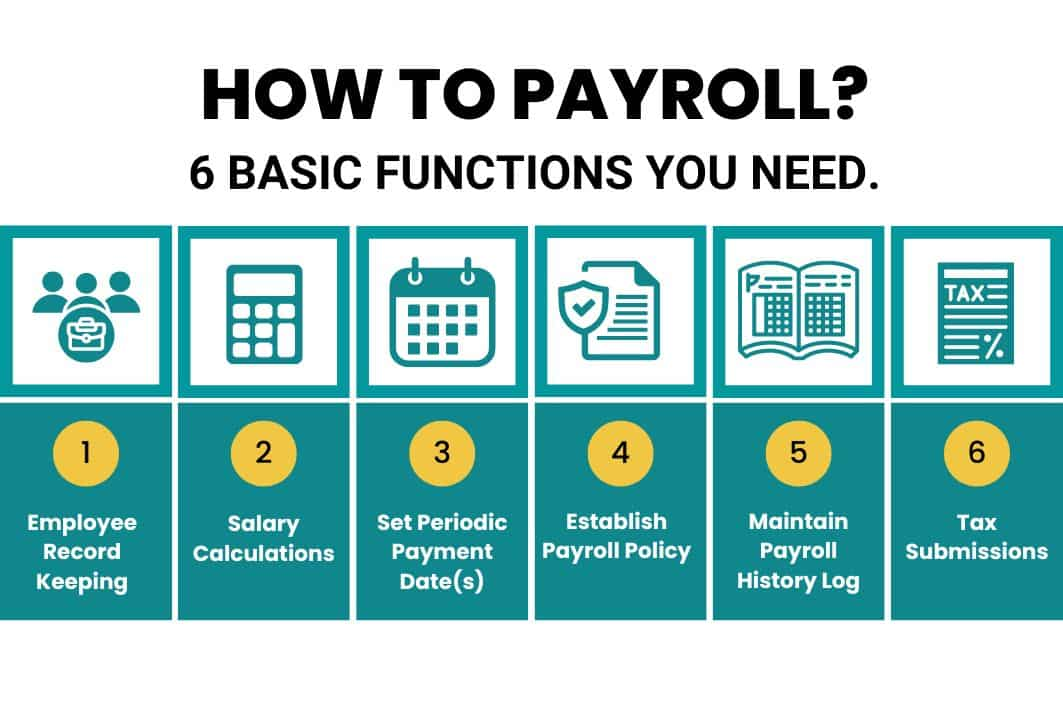Payroll refers to all the financial records and data pertaining salaries, wages, overtime, bonuses, deductions related to entities, employees, owners or partners paid for services provided during a specific period of time. Such information is generally required for the filing of taxes and submission of regulatory forms. It may seem simple and easy, but Payroll itself contains a lot of sensitive information that needs to be handled systematically and accurately. Every business needs a Payroll system in place, even if there’s only one or two employees.
We talk a lot about the importance of a Payroll Software and how it contributes to efficiency within Human Resource(HR) operations. However for those of you who are just starting out and haven’t had much exposure to how Payroll is done, the actual task of processing your business’ payroll can get increasingly complex and difficult to manage. As a Payroll Software provider we’ve seen what it takes for businesses to achieve an efficient Payroll system, so whether or not you intend to process your business’ Payroll through a Payroll Software, Excel or even on Paper, here are some key steps that you can take to build the best Payroll system for your business.

Step 1. Employee Record Keeping
Having a detailed record of each employee is the first thing you want to start with. Aside from complying with the requirements of Ministry of Human Resources (MOHR), building a solid employee database is essential for any Payroll system to function. A proper management of employee records can also contribute to you being able to effectively monitor the performance and productivity of your employees.
Key components in Employee Records that you’ll want to include:
- Basic Information – Refers to personal information such as employee’s full name, identification number, nationality, address, birth date, contact number, employment date etc. This section can also include emergency contacts.
- Salary Details – This includes various components of an employees’ salary, namely basic pay, bonuses, commission and contributions.
- Statutory Information – Income Tax Reference number, Banking Info and Immigration Info where applicable. Information here is generally also required for tax reporting purposes.
- Confidential Agreements/Documents – Employee contracts, resumes, resignation agreements etc. should be kept in your employee records for easy access and referring for checks.
Step 2. Salary Calculations
Now that you’ve got your employee database ready, the next step is putting together the components of employees’ salary. Some key considerations to factor in:
- Are employees’ salary calculated by hours or days?
- How is no pay leave calculated?
- If your employees are entitled to bonus, how is it measured?
- How should overtime be calculated?
- If employees are late or early for work, how do you calculate allowances and deductions?
It’s always a good idea to classify your employees, whether they are full-time, part-time or contract, with there being different tax requirements and minimum wage regulations you’ll want to adhere to. Additional components that must be factored into employees’ salary:
- EPF Contributions – Businesses operating in Malaysia are expected to comply with EPF (Employees’ Provident Fund) contributory requirements.
- Foreign Worker Levy (FWL) – If your business employs foreign workers, there is a compulsory levy requirement and foreign headcount quotas to comply.
- Contribution to Potongan Cukai Bulanan – Ensure Potongan Cukai Bulanan (PCB) contributions are automated to avoid penalties. Say goodbye to stress such as these by using Malaysia Payroll Software.
Step 3. Set Periodic Payment Date
Employees cannot go too long without a salary, and you can’t possibly be processing Payroll say, every day. It’ll be a complete nightmare! Non-payment of salary will be considered an offence.
Step 4. Establish Payroll Policy
For your employees to know when to and what to expect on payday, you must establish relevant payroll policies that are clearly communicated to, and understood by all of your employees.This will include:
- Salary calculations, Pay Periods and Payday – You’ve already established a process for reimbursement of employees’ salaries. The next step is to ensure your employees are aware of pay periods and paydays that are relevant to them. Should they be paid on a monthly basis, they will need to know the start and end dates for the month long pay period, and the actual payday.
- Time & Attendance Guidelines – Clearly state what your employees need to do in order to achieve a proper time sheet submission. For those of you who record employees’ time & attendance manually and require employees to fill out a time sheet, you may want to convey rounding procedures, time sheet submission deadlines, who is assigned to endorse them and most importantly, highlight the consequences of falsifying time sheets.
- Employee Benefits – Break down the benefits offered to employees and how they can be obtained. Employee benefits may include annual leave entitlements for vacation, sick, personal and bereavement, health and life insurance, business expense reimbursements and paycheck advances.
Additionally, Opensoft Malaysia Payroll Software automatically generates itemised payslips for all employees covered under the Malaysian employment act.
Step 5. Keep Track of Payroll History
If there is no proper documentation of payroll history, it can be quite difficult to answer to management when an issue pertaining to past payroll data crops up at some point in the future. Common situations where businesses require to dig up past payroll records include difficulties in balancing accounting books within the finance department, and discrepancies in salary payments.
Step 6. Ensure Tax Submissions
Avoid unnecessary penalties of your business’ taxes by constantly keeping yourself updated with the latest regulations and submission dates. Malaysian businesses are expected to prepare accurate and timely submissions to Inland Revenue Board of Malaysia (IRBM) .
With Opensoft Malaysia Payroll Software all your tax submissions can be automated so late submissions will no longer be a problem.
Useful Payroll Tools
Using a good payroll software such as the Opensoft Malaysia Payroll Software would not only automate your processes, but it can be linked with other solutions such as Time and Attendance, eLeave, eClaims etc, as having all these processed linked up makes sense in enhancing payroll productivity.
 Home
Home





